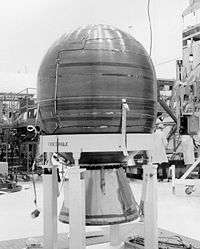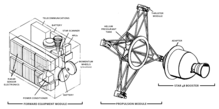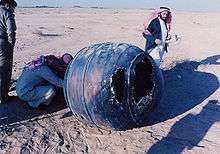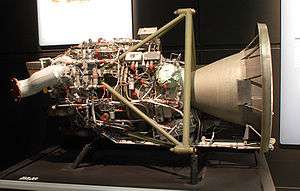Star 48
Star 48 is a type of solid rocket motor used by many space propulsion and launch vehicle stages. It is used almost exclusively as an upper stage. It was developed primarily by Thiokol Propulsion, and is now manufactured by Orbital ATK, which purchased Thiokol in 2001.[1] A Star 48B stage is also one of the few man-made items sent on escape trajectories out of the Solar System, although it is derelict since its use. The Star 48B variant was the PAM-D upper stage used on the now retired Delta II rocket.
 Star-48B rocket motor | |
| Country of origin | United States |
|---|---|
| Date | 1982 - present |
| Manufacturer | Thiokol |
| Predecessor | Star 37 |
| Solid-fuel motor | |
The Star 48 has been used as a third stage in three-stage launch systems.

Overview
The "48" designation refers to the approximate diameter of the fuel casing in inches; Thiokol had also manufactured other motors such as the Star 37 and Star 30. Internally, Thiokol's designation was TE-M-711 for early versions, and TE-M-799 for later ones. Subtypes are given one or more letter suffixes after the diameter number, or a trailing number (i.e., "-2") after the internal designation. Not surprisingly, the "T" prefix stands for Thiokol, and the following letter refers to the company division that developed the rocket motor. In this case, "E" refers to the Elkton, MD division and the "M" stands for motor.
The most common use of the Star 48 was as the final stage of the Delta II launch vehicles. Other launchers have also incorporated the motor, but with lower frequency. In such usage, the complete stage (motor plus accessories) is referred to as the Payload Assist Module (PAM), as the Shuttle could only take satellites to low Earth orbit. Because geostationary orbit is much more lucrative, the additional stage was needed for the final leg of the journey. On such missions, the stage is spin-stabilized. A turntable, mounted in the shuttle payload bay or atop the previous Delta stage, spun the PAM and payload to approximately 60 rpm prior to release.
Usually after motor burnout and just prior to satellite release the PAM is de-spun using a yo-yo de-spin technique.
A non-spinning, thrust-vectoring version of the Star 48 is available ("Star 48BV"), but much less common. A thrust-vectoring Star 48 is the final stage of the Minotaur IV+ launch vehicle.
In 2013 a Star 48GXV was tested for the Solar Probe Plus mission (which later was renamed to the Parker Solar Probe).[2] A Star 48BV was used in conjunction with a Delta IV Heavy for the Parker Solar Probe launch in 2018.[3][4]
A Star 48 motor used in the 3rd stage of the New Horizons probe was the first part of the New Horizons mission to reach Jupiter, arriving before the probe.[5] It also crossed Pluto's orbit in 2015 at a distance of 200 million kilometers.

A Star 48 Payload Assist Module that had been used to launch a GPS satellite in 1993, crashed in the Saudi Arabian desert in January 2001, after its orbit decayed. The unit did not burn up on reentry and was positively identified on the ground.[6]
Star 48B
The Star 48B version has an extra 11 kilograms of propellant more than the regular Star 48, for a total of 2011 kg.[7] There is a version of the Star 48B that is lengthened and also heavier, called the Star 48B L.[8]
In operation as a third stage, the Star 48B sits on top of spin table, and before it is separated it is spun up to stabilize it during the separation from the previous stage.[9] (see also Spin-stabilisation) The Star 48B can produce 15,000 pounds of thrust (66 723 newtons), with a burn time of 1 minute 27 seconds.[10]
The Star 48B is basis for the McDonnell Douglas PAM-D upper stage used on the Delta rocket.[10]
Use on New Horizons
A Star 48B was used on the third stage of the New Horizons spacecraft launch.[11] New Horizons was launched by its stack in January 2006, and the Star 48B booster was launched along with the New Horizons's spacecraft on an escape trajectory out of the Solar System.[12] The Star 48B ignited and burned for 48 seconds, taking both on a trajectory past Pluto; however because the Star 48B became derelict and did not have course corrections like the NH spacecraft, it was projected to miss Pluto by hundreds of millions of miles.[12]
New Horizons Star 48B was calculated to arrive at Jupiter six hours before New Horizons, and on October 15, 2015 passed through Pluto's orbit at a distance of 213 million kilometers (over 1 AU) distant from Pluto.[12][13] This was nearly four months after the New Horizons probe did.[5]
See also
References
- ATK Space Propulsion Products Catalog (PDF). ATK. 2012. pp. 99ff. Retrieved 2013-06-06.
- "ATK and NASA Successfully Demonstrate New Rocket Motor for Solar Probe Plus Mission". Prnewswire.com.
- Clark, Stephen (March 18, 2015). "Delta 4-Heavy selected for launch of solar probe". Spaceflight Now. Retrieved March 18, 2015.
- "ULA's heavy-lifter rolled out for solar probe launch – Spaceflight Now". spaceflightnow.com. Retrieved 2018-11-05.
- "Derelict Booster to Beat Pluto Probe to Jupiter". Space.com.
- "PAM-D Debris Falls in Saudi Arabia" (PDF). The Orbital Debris Quarterly News. NASA Johnson Space Center. 6 (2): 1. April 2001.
- "Star 48B". Astronautix.com. Retrieved 2018-10-22.
- "Star 48B l". Astronautix.com. Retrieved 2018-10-22.
- Michael J. Muolo (1993). Space Handbook: A War Fighter's Guide to Space, V. 1. Government Printing Office. p. 126. ISBN 978-0-16-061355-5.
- "PAM-D Payload Assist Module Archives - This Day in Aviation". This Day in Aviation. Retrieved 2018-10-22.
- ":Press kit : NASA's First Mission to Pluto and the Kuiper Belt" (PDF). Nasa.gov. Retrieved 22 October 2018.
- Stern, Alan; Guo, Yanping (October 28, 2010). "Where Is the New Horizons Centaur Stage?". Johns Hopkins University Applied Physics Laboratory. Retrieved 2018-10-22.
- "Star 48b Third-stage Motor - Unmanned Spaceflight.com". Unmannedspaceflight.com.



